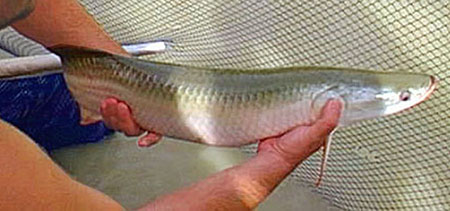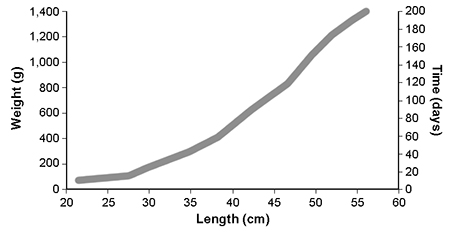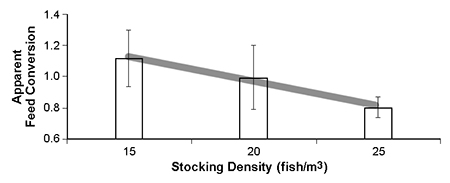Reliable seedstock, feed supply needed to grow world’s largest freshwater scaled fish

The pirarucu or Brazilian freshwater cod (Arapaima gigas), an endemic fish species from the Amazon River basin, is the largest freshwater scaled fish in the world. It can reach up to 200 kg in weight and 3 meters in length. Without intermuscular bones, pirarucu fillets have good flavor and enjoy high acceptance in Amazon fish markets.
Experimental and pilot husbandry of this hardy fish in confined enclosures has produced encouraging results. Initial research work was carried out at the Centro de Pesquisa Agroflorestal da Amazônia Oriental from Empresa Brasileira de Pesquisas Agropecuarias in Belem, Para, Brazil in the 1980s. Pirarucu grown in excavated earthen ponds and fed with forage fish (tilapia) reached a mean weight of 10 kg in one year and a total productivity of 10 ton per hectare per year.
Developing intensive husbandry
The Amazon basin has a variety of water bodies suitable for different types of fish culture systems. The current challenge is to develop an intensive husbandry system for pirarucu that increases stocking densities while maintaining high water quality standards.
Pirarucu have a positive aggregated behavior and do not exhibit cannibalism among animals up to 5 kg, which facilitates their husbandry at high stocking densities. Unlike other species with an obligatory aquatic respiration, their remarkable aerial respiration capability also allows the species to be confined under high densities, particularly in cages.
Cage culture

Floating cage culture is an effective and economically viable fish production technology applicable to many aquatic environments. Cages confine aquatic organisms, provide adequate water quality and growth conditions, and easy feed management. They also protect against predators and competing animals.
Production of pirarucu in floating cages appears to be a viable alternative that can be implemented by small enterprises such as family businesses, or scaled up to a highly intensive commercial scale.
Cage size is an important factor in pirarucu husbandry, because initial growth in this species occurs primarily in length and over a very short time period (Fig. 1). Limiting the space inside the cages makes it difficult for the fish to swim, access food, and fully reach their growth potential. Cages of 1 cubic meter are appropriate for initial grow-out of pirarucu, until fish reach around 1 kg and/or 50 cm length. Pirarucu juveniles grown in these cages at high stocking densities up to 25 animals per cubic meter have had feed-conversion rates under 1.0 (Fig. 2).

of pirarucu juveniles grown in small-volume cages.
Larger, 18-cubic-meter (3 x 3 x 2 m) cages are recommended for further grow-out. The initial stocking biomass in these cages can be around 10 kilogram per cubic meter. In a one-year period, the fish can reach an average weight of around 15 kg and a productivity of 150 kilogram per cubic meter. These preliminary results show potential for pirarucu production in confinement.
High-protein diets
Pirarucu are carnivorous and require an expensive, extruded feed with a protein content of greater than 40 percent crude protein, which increases production costs. Despite these higher costs, it is an attractive commodity and its commercial production is attractive because of the high value that pirarucu enjoys in the Amazonian market.
Conclusion
The pirarucu is a promising fish species for intensive cage production in the Amazon region. However, additional research in several areas is needed, including a protocol for reliable captive reproduction to supply seedstock demands and more specifically formulated aquafeeds. Also needed are better treatment protocols for diseases, and improved knowledge of stocking densities and production biomass.
Financial support for research was provided by Conselho Nacional de Desenvolvimento Científico e Tecnológico/CNPq /MCT/Brazil, and Agencia Española de Cooperación Internacional (Projeto Pirarucu).
(Editor’s Note: This article was originally published in the October 2002 print edition of the Global Aquaculture Advocate.)
Now that you've finished reading the article ...
… we hope you’ll consider supporting our mission to document the evolution of the global aquaculture industry and share our vast network of contributors’ expansive knowledge every week.
By becoming a Global Seafood Alliance member, you’re ensuring that all of the pre-competitive work we do through member benefits, resources and events can continue. Individual membership costs just $50 a year. GSA individual and corporate members receive complimentary access to a series of GOAL virtual events beginning in April. Join now.
Not a GSA member? Join us.
Authors
-
Bruno Adan Sagratzki Cavero
Aquaculture Department
Instituto Nacional de Pesquisas da Amazonia
C.P. 478
Manaus, AM, 69011-970 Brazil[114,98,46,118,111,103,46,97,112,110,105,64,99,115,97,98]
-
Rodrigo Roubach
Aquaculture Department
Instituto Nacional de Pesquisas da Amazonia
C.P. 478
Manaus, AM, 69011-970 Brazil -
Manoel Pereira Filho
Aquaculture Department
Instituto Nacional de Pesquisas da Amazonia
C.P. 478
Manaus, AM, 69011-970 Brazil -
Daniel Rabello Ituassu
Aquaculture Department
Instituto Nacional de Pesquisas da Amazonia
C.P. 478
Manaus, AM, 69011-970 Brazil -
Andre Lima Gandra
Frigorífico Iranduba, AM, Brazil
-
Roger Crescencio
Embrapa Acre
Rio Branco, AC, Brazil
Tagged With
Related Posts

Innovation & Investment
Pirarucu culture in the Brazilian Amazon
With their fast growth and ample light-flavored flesh, pirarucu present great potential. Industry growth is hampered by limited technology and management of domestication practices. Also, current commercial diets are typically not fully suited to the nutritional needs of pirarucu.

Responsibility
Changing the production chain of Amazonian pirarucu
Studies in Brazil over the last five years addressed the challenges facing commercial producers of the important, air-breathing, freshwater fish pirarucu in order to support and expand production.

Health & Welfare
Aquaculture of Amazon fish in Latin America
Many fish species that live in the Amazon basin have great potential for aquaculture. The main species currently cultured in the region is tambaqui, a fast-growing, omnivorous fish that tolerates poor water quality.

Health & Welfare
Arapaima a candidate for intensive freshwater culture
Arapaima, also known as pirarucu or paiche, offers appealing flesh color and texture, low fat content and high levels of protein and fatty acids.


